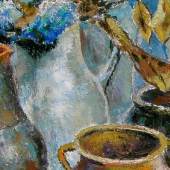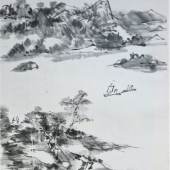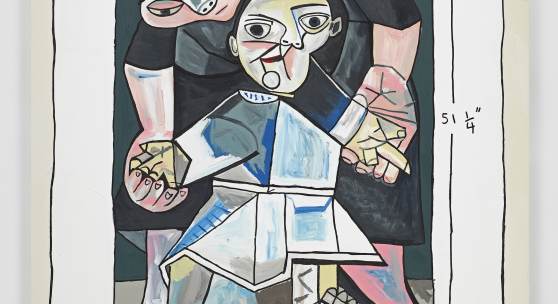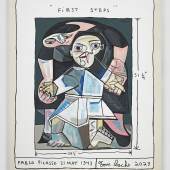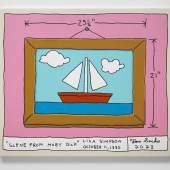Ropac Marais
Tom Sachs "Paintings"
-
Ausstellung17.01.2024 - 24.02.2024
If you want to learn how to paint, start by painting your own Picasso.
— Tom Sachs
For this exhibition at Thaddaeus Ropac Paris Marais, Tom Sachs has immersed himself in paintings Pablo Picasso produced during his so-called ‘War Years’, between 1937 and 1945. Reimagining Picasso’s work using his own distinctive painterly language, Sachs also challenges Picasso by contrasting him with two opponents: longstanding rival Marcel Duchamp and a more contemporary adversary, Lisa Simpson. This exhibition brings Sachs’s reinterpretations of Picasso, Duchamp and Simpson’s works into conversation to create a wry reflection on the purpose of painting.
Painting is a medium Sachs has returned to several times over the years, and the works on view were conceptualised in a period of focus on drawing and colour for the artist. In his New York studio, he surrounded himself with the work of some of the masters of Modern art: Picasso and Duchamp, two giants of the 20th century. The Modernist painter and the boundary-pushing ironist are often positioned in opposition to one another, and their different approaches to what makes a work of art – both of which Sachs identifies with in different ways – prompted Sachs to bring the two head-to-head in “Painting”.
Exploring the lines and forms used by Picasso in the Spanish painter’s lesser-known works created starting in 1937, Sachs found parallels with his own practice. The thick lines that recur in Sachs’s work, originating from the influence of American graffiti and street art, mimic the solid black linework that delineates many of Picasso’s figures. Sachs’s choice of the works he would reimagine for the exhibition reflects many of the notions he discovered in Picasso’s works that vibrantly resonated in a contemporary context.
The horrors of war and the reality of mortality weighed heavily on Picasso. As such, the still lifes in the exhibition are devoid of softer memento mori – fruit or flowers, for example – and are instead centred around human skulls, the heads of beasts, and the barbed forms of sea urchins. In contrasting complement to this sentimental approach, Picasso’s playful and touching scenes of childhood – often depicting children from his own family and from his entourage – seem to connect movement and life with the hope of a new generation.
Sachs’s affinity with aspects of Picasso’s work is intriguingly disrupted by the critical eye Sachs has long cast at traditional methods of artmaking used by artists such as Picasso, as Sachs, like Duchamp, invites viewers to see everyday objects as sculpture. In the midst of the journey through Picasso’s work with its meandering lines and blended colours, Duchamp’s bold black, red and white Rotorelief introduces the viewer to the rivalry between the two leaders of Modern art. While Picasso’s works are recreated at their original scale, Sachs’s reimagination of Duchamp’s Rotorelief dramatically expands it to 10 times its initial size. With its imposing new scale, strength of colour and sharp lines, the single Duchamp piece finds its voice among the Picassos that surround it, encouraging the viewer to engage with the challenge that it poses to more traditional conceptions of what constitutes a work of art.
When Duchamp debuted his Rotoreliefs in 1935, at 20 centimetres in diameter, the discs were a commercial object – exhibited at a fair for inventors, they were marketed as optical illusions rather than paintings to be hung on a wall. Sachs’s longstanding interest in mass production, industrialisation and commercialism, and his exploration of and playful engagement with these themes in his own practice, would have placed him firmly in Duchamp’s camp, rather than in Picasso’s. As such, through his reworking of Rotorelief for the exhibition, Sachs’s fascination with the place of consumerism in art provides a counterpoint to the purist approach represented by Picasso.
Women were frequently included in Picasso’s paintings, often through the lens of their relationships with him and as symbols bearing the world’s pain. Sachs’s unexpected inclusion of his version of a work by ‘Lisa Simpson’, a character from the animated television series The Simpsons – a ‘painter’ who is both female and fictional – is a direct challenge to Picasso’s approach. Echoing a key tenet of Sachs’s own work, finding a place for humour, irony and play in artmaking, the character, who has no formal training, paints for pleasure and has no personal relationship to Picasso, is the ultimate rival that Picasso could not have anticipated. Her painting, which hangs over the iconic Simpsons sofa – and which Sachs ventures might well be ‘the most seen painting in the world’ – makes Lisa a formidable opponent.
By placing a Lisa Simpson work in dialogue with his recreations of Picasso’s and Duchamp’s, Sachs suggests a fresh alternative to established perspectives on what art is for. In introducing Picasso to Lisa Simpson, Tom Sachs completes his ultimate Duchampian gesture.
- << Berlin Art Week 2024
- zurück | vor
- The Bad Mother >>
-
09.09.2021 - 13.09.2021The upcoming edition of Maison&Objet Paris will take place from the 9th to the 13th of...
-
08.11.2023 - 12.11.2023Paris Photo, the leading international fair dedicated to photography, announces its premiere line...
-
13.09.2019 - 17.09.2019La Biennale Paris 2019 will be held at the Grand Palais from 13 to 17 September 2019,...
-
Dieser neue "Naturalismus" spiegelte sich bereits in frühen Werken der Renaissance, so...
-
17.01.2024 - 24.02.2024
Opening
Wednesday 18 October 2023, 10pm—12am
with the artist present18 October 2023—27 January 2024
Thaddaeus Ropac
Paris Pantin
69, avenue du Général Leclerc
93500 Pantin
France


